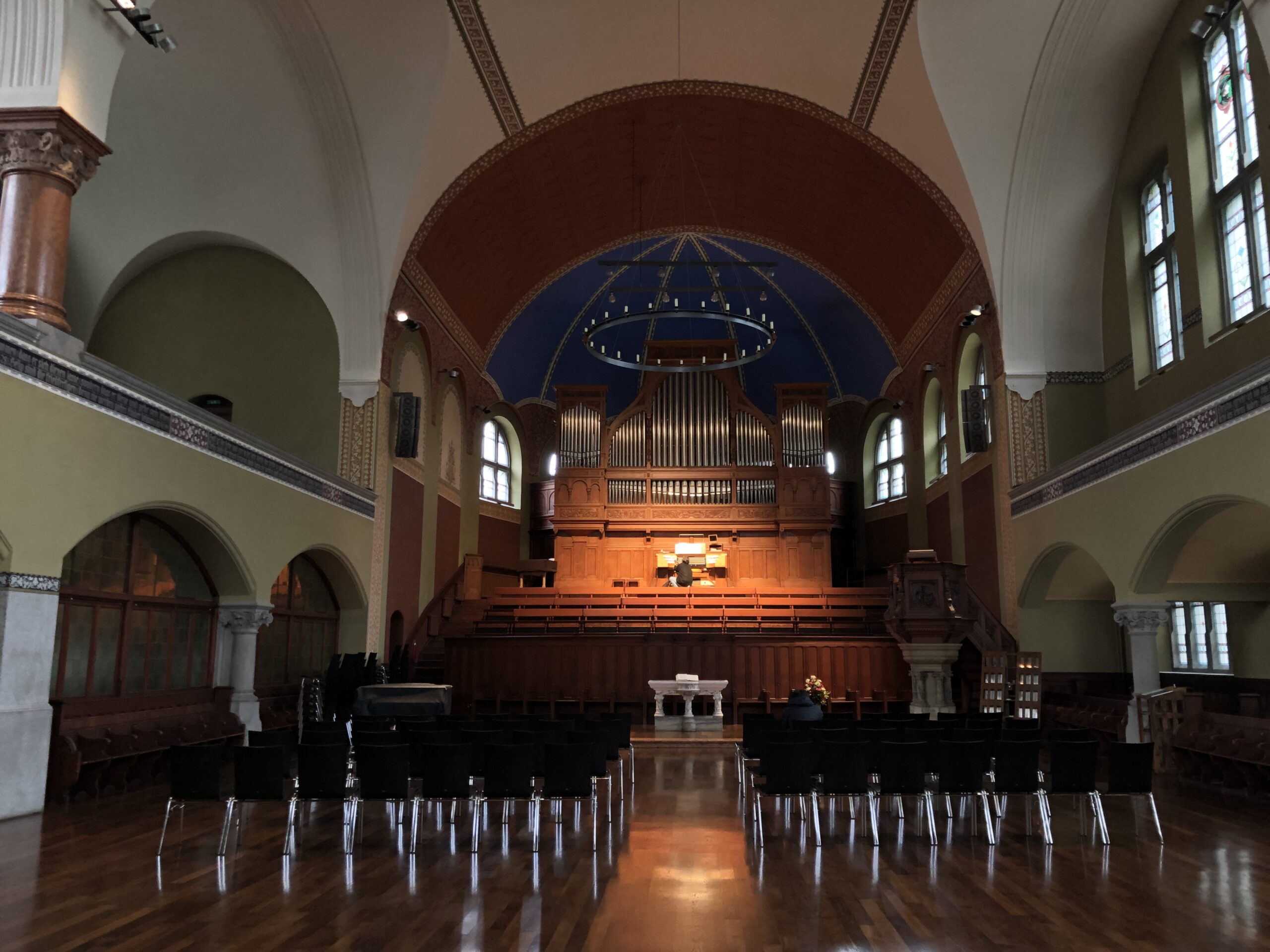ASSIGNMENT 1
St. Jakobs Church
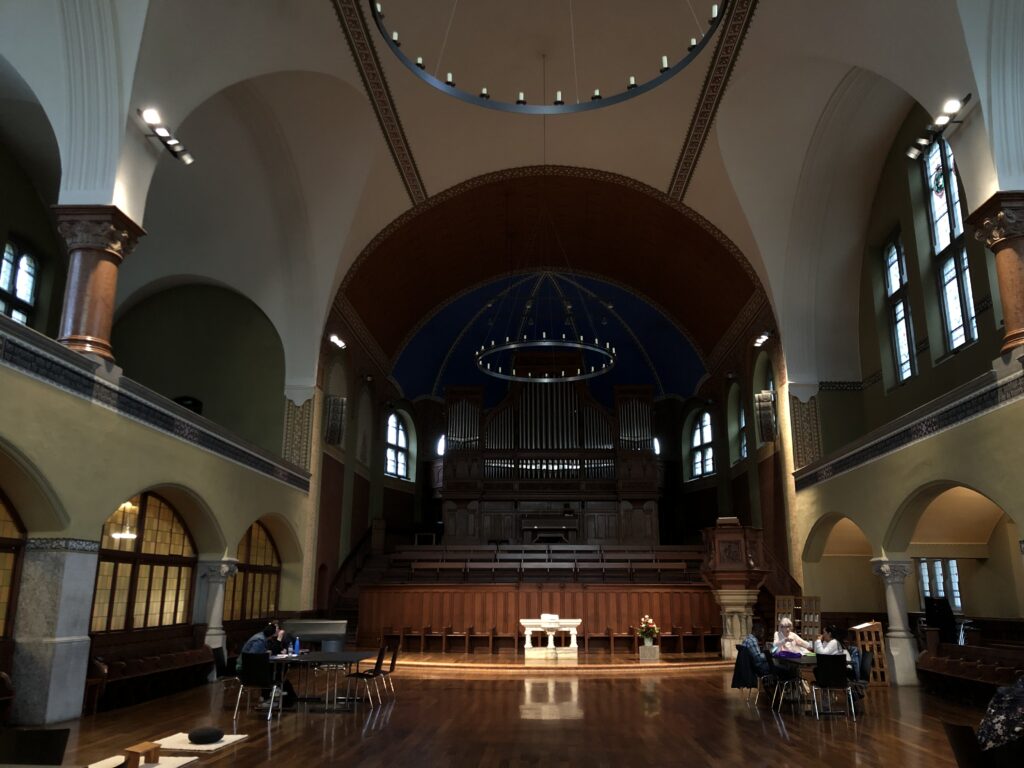
The church is deconsecrated and no longer serves as a traditional place of worship. Instead, it functions as a versatile space used for a variety of purposes such as meetings, co-working sessions, conferences, prayer groups, dance events…
The church has a central nave with a side aisle on the right and a separate room on the left that can be accessed through a door. The apse features a staircase, and an organ is located in this space. The side area is divided into two levels, creating a balcony-like space. The ceiling is circular in shape, with multiple domes extending outward from it. Above the apse, there is another dome. Before entering the main hall, there is a foyer connected to a small exterior porch, which leads to the adjacent square.
Acoustically, it is noteworthy due to its reverberant nature. This quality can enhance musical performances like organ concerts, making the sound rich and immersive. However, the same reverberation can be a drawback during conferences or speeches, as it makes spoken words hard to understand and creates an echo-heavy environment. These contrasting acoustic behaviors create entirely different atmospheres, depending on the use of the space.
The reverberation in the church gives the space a grand, almost spiritual feeling when music is played, like the sound swells and surrounds you from every direction. However, during conferences or when people are speaking, the echo can make it hard to focus, with sounds bouncing back at you from different parts of the room. It feels like the space is too “live” for spoken words to land clearly, and that can be distracting.
List of Acoustic Events and Sources
- Inside the Church (Daytime):
- Reverberating voices
- Passing tram noise from outside
- Coughing
- The sound of pens tapping
- Chairs moving
- Cars from outside
- Sounds from outside generally enter from the rear, while voices are primarily heard from the front, and coughs come from the left side.
- Inside the Church (When Organ is being played):
- Organ music
- Background noises from people moving or shifting around
Acoustic Terminology (Adjectives)
Live: The church hall is highly reverberant, causing sounds to echo and linger throughout the space, especially during music performances.
Reverb-y: The space has a significant amount of reverberation, with sounds continuing to resonate after they are produced
Boomy: Lower frequencies, particularly from the organ, resonate strongly, creating a deep, powerful sound that fills the hall.
Cavernous: The large volume and domed ceilings give the space an expansive acoustic quality, making sounds feel vast and echoing.
Resonant: Certain frequencies, resonate more strongly, emphasizing specific tones like voices or organ notes.
Square in front of the St. Jakobs Church

This public square serves as a resting spot or a passageway between the surrounding streets. It lies between a block of buildings, St. Jakobs Church and two streets. It is accessible by foot and if needed by car. Many people pass through this area when coming from the nearby tram station or as they head towards the church entrance.
The square has a trapezoidal shape, surrounded by trees, with mineral pavement covering most of the surface. A central green area connects the square to the church. This green element, elevated 60 cm above the pavement, is also used as seating. On one short side of the trapezoid is the church, while the other side faces a busy tram stop.
Acoustically it is interesting because of the variety of sounds that can be heard simultaneously. It is a dynamic space where you can hear people talking, the sound of trams, noises coming from the church, bells ringing, and even pigeons taking flight. The complexity of these overlapping sounds makes it an intriguing place from an acoustic perspective.
The square is alive with a mix of urban and natural sounds. There’s the constant noise from trams and traffic from the nearby road, but you also hear the fluttering of pigeons, the ringing of church bells, and snippets of conversations from people passing by. It’s a space where multiple soundscapes coexist, and it feels vibrant and energetic because of that. You’re never in complete silence, but there’s a flow to the sound that keeps it interesting.
List of Acoustic Events and Sources
- Church bells
- Footsteps of people walking
- Conversations
- Tram noise
- Cars
- Someone moving objects around
- The sound of paper being unwrapped
- Pigeons flying off
- Suitcases being rolled across the mineral pavement
Acoustic Terminology (Adjectives)
Busy: The square has an intricate soundscape, with overlapping sounds from people, trams, and the nearby traffic, creating a dense sonic environment.
Open: Despite the surrounding noise, the square feels acoustically spacious, with sounds from the environment blending naturally without confinement.
Crisp: Individual sounds, like footsteps and conversations, are clearly defined, especially in contrast to the background hum of traffic and trams.
ASSIGNMENT 2
For this exercise, I decided to choose a room in my flat at two different times and situations. It was renovated a few years ago, including the windows, and is on the 4th floor of a building. It is on a side street, but close to the motorway entrance and a busy road.
This means that when the windows are acoustically closed, there is no connection to the outside environment, while when they are open, or when you are on the terrace, the sounds of the neighbourhood are loud.
I decided to listen to the sounds in my room with all the windows closed and then with the windows open, because I found it interesting to hear the difference in the same room in two different situations.
Sounds with the windows closed:
- My flat mate working (pen writing, papers, chair moving, footsteps moving around the flat). Sounds also accompanied by different vibrations, e.g. floor;
- Washing machine;
- People in the stairwell going to their flats;
- Ground floor front door closing.
When there are no such events, the apartment is in total silence, a situation that is sometimes pleasant, sometimes almost unpleasant.
In all cases, the sounds that can be heard are those produced by people, their movements and their activities.
When the windows are open, the following sounds are added
- Cars;
- Trucks;
- People talking;
- Bicycles stopping/moving;
- People working in the street.
These are always man-made. Natural sounds are very faint or absent. During the day of observation the weather was fine, if the weather conditions had been different (rain/strong wind/…) it would have influenced the analysis.
It is interesting to compare the emotional response and human perception in the two situations. When the windows are closed and there is silence, the smallest changes are perceived much more and affect the emotions more, especially in alarming situations. If a child is running down the stairs, my attention is focused on that. Or if there is a piece of metal in the washing machine and it keeps hitting the machine, my attention is immediately drawn to that sound.
On the other hand, if the situation is very quiet and there is almost no sound, I hear a very quiet frequency/sound. I would almost say I hear silence – difficult to describe. This can be pleasant, but sometimes strange, because what you hear most are the sounds of your own body. I often prefer to put on some background music in these situations.
When I open the windows, everything changes. There is a very dominant background sound, and then everything that is happening in the flat fades into the background. You can hear the cars, like a stream coming from the motorway, which does not bother you because it is constant. What affects me most emotionally are the cars that pass by one by one, and even if it is just for a short moment, the sound they make is dominant and attracts my attention and disturbs me.
However, I have noticed that when I live in this flat, I choose which sound environment I prefer according to my emotional state. For example, at night I like to close the window to be quiet, but then some mornings I like to wake up and hear the sounds coming from outside, while others I like to remain silent for longer.
The same happens when I have to work, sometimes I prefer to work in total silence, sometimes I like to have a background sound from the city.
ASSIGNMENT 3
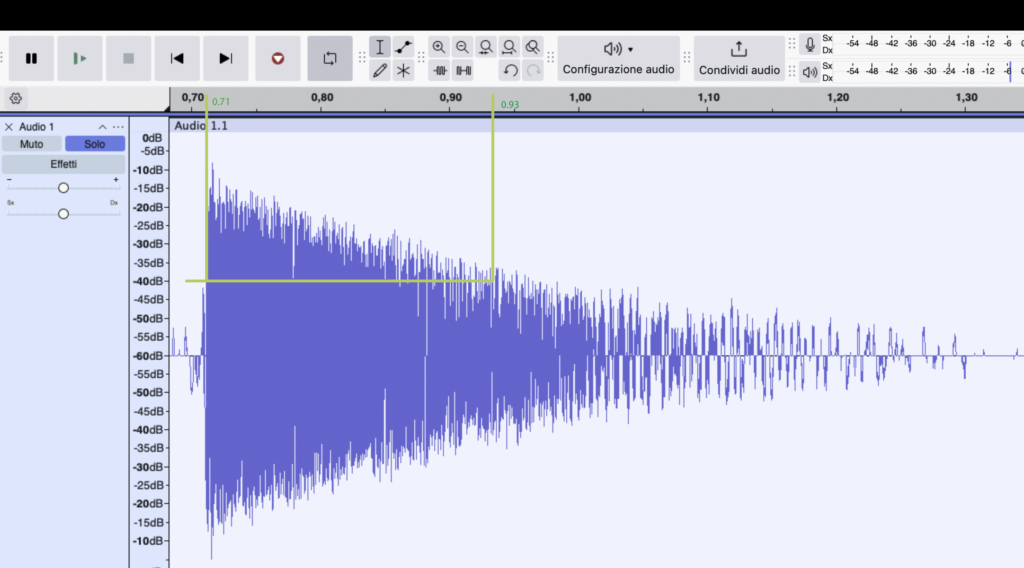
30dB decrease takes 0.22 sec. RT60 = 0.22 (sec) x 2 = 0.44 sec
No echoes are visible on the picture.

The reverberation Time without abs. at 500 Hz = 2.1, while at 1000 Hz = 2.2.
The reverberation Time with abs. at 500 Hz = 0.3, at 1000 Hz is it almost the same, 0. 28 ca.
ASSIGNMENT 4
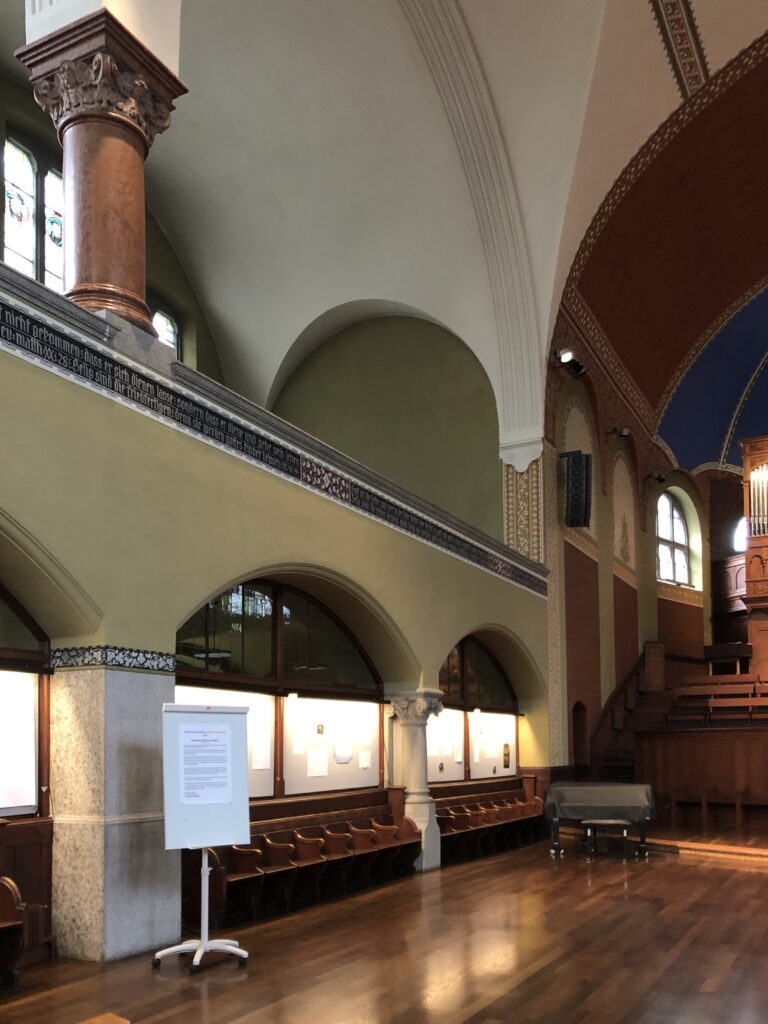
I went back to Stauffacher Church, as it’s the space that intrigues me most acoustically, especially considering its potential for improvement.
Right now, there aren’t any significant absorbers in the space. The only absorptive elements are the chairs and people present—factors that aren’t fixed and vary depending on the event.
The building is primarily made of materials with low absorption coefficients that mostly reflect sound. The main materials here are plaster, wood, and glass. For the church’s primary function, these reflective qualities are actually beneficial: when the organ is played, the sound is amplified and clearly heard throughout most of the space. The wood and glass are especially reflective, but I believe it’s primarily the building’s geometry that enhances the wide diffusion of sound. The domes appear to be coated with plaster, though likely only in a thin layer.
The challenge arises when the church is used for gatherings, discussions, or other activities that produce different frequencies and sound qualities from various points in the space.
This situation presents an interesting case study, as the space demands different acoustic qualities depending on the event. A flexible, layered system that could be adapted easily might be ideal. I could imagine adding furnishings that encourage diffuse reflection, like curtains on the ground floor, or elements with high absorption coefficients, that can be moved. If activities are primarily on the ground floor, the first floor could also be used to place these absorptive elements.
With a more detailed study of the space’s usage and sound propagation, we might identify plaster walls that could be adjusted for improved absorption. However, I’d avoid altering the concave surfaces, as they seem crucial for sound propagation, particularly when the organ is played.
Landscape acoustic
As object I choose the window in my room, as it plays a main role for the use and quality of the room.
As I can not bring the object on place, I did a second recording, of a sound I often reproduce in my room: the striking of a match.
THE FULL PICTURE AND FINAL ASSIGNMENT
At the start of the semester, the Stauffacher Church sparked my curiosity, raising several questions: Who uses it? Can a church serve multiple purposes? How do people interact with it? Considering its acoustic limitations for diverse activities, I wondered if a mobile system could enhance its sound quality while preserving its sacred essence.
Throughout the semester, I visited the church several times to observe its usage. I noticed it hosting various activities: language classes, co-working, music practice, dance events, and yoga. This variety surprised me, particularly how a place of worship could accommodate such diverse functions, including high-volume music events.
As the room was often in use, I couldn’t take precise measurements. However, audio recordings provided some general insights into the acoustics.
Meanwhile, I reflected and did measurements on sound in my room, where I can easily control the acoustics by opening or closing the window to either let in traffic noise or maintain silence. This control contrasts with the fixed acoustics of the church, making me question whether it’s necessary—or even desirable—to adapt a church’s acoustics to various activities.
This inquiry into the relationship between geometry and sound interests me a lot. The church’s design significantly influences its acoustics, and despite potential modifications, achieving optimal sound for every activity might remain challenging. Exploring ways to adapt its acoustics intrigues me, as it could unlock greater potential for multifunctional use while honoring the building’s original purpose.
Over the past two weeks, I have focused on the relationship between geometry, sound, and space—specifically within the context of architecture and music. As I researched, I encountered a range of ideas and examples that both fascinated and challenged my thinking. At times, this relationship seemed full of potential, offering a wealth of inspiration. At other times, it appeared less compelling, and I wondered if besides acoustic I would have found other interesting links. Nevertheless, one conclusion became clear: architecture and music are connected, and bringing these two forms closer together can lead to infinite possibilities for creative exploration.
To begin this exploration, I will present various objects, buildings, music pieces, and ideas that illustrate how geometry, sound, and space interact. I selected some examples I encountered, that serve as an initial point for further research and thought, potentially leading to more significant insights.
The Role of Acoustics in Shaping Music
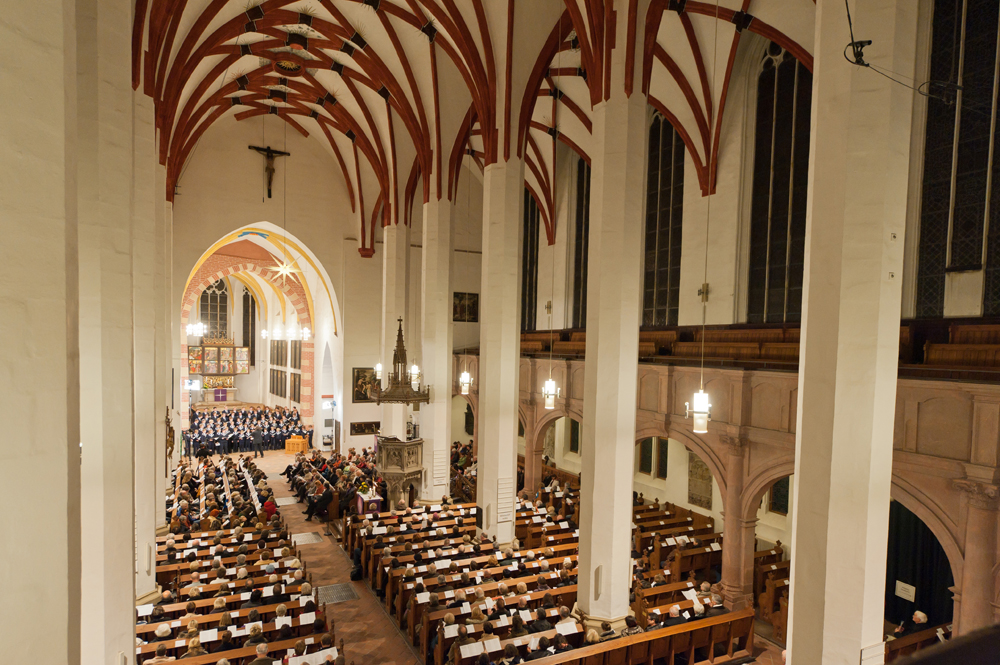
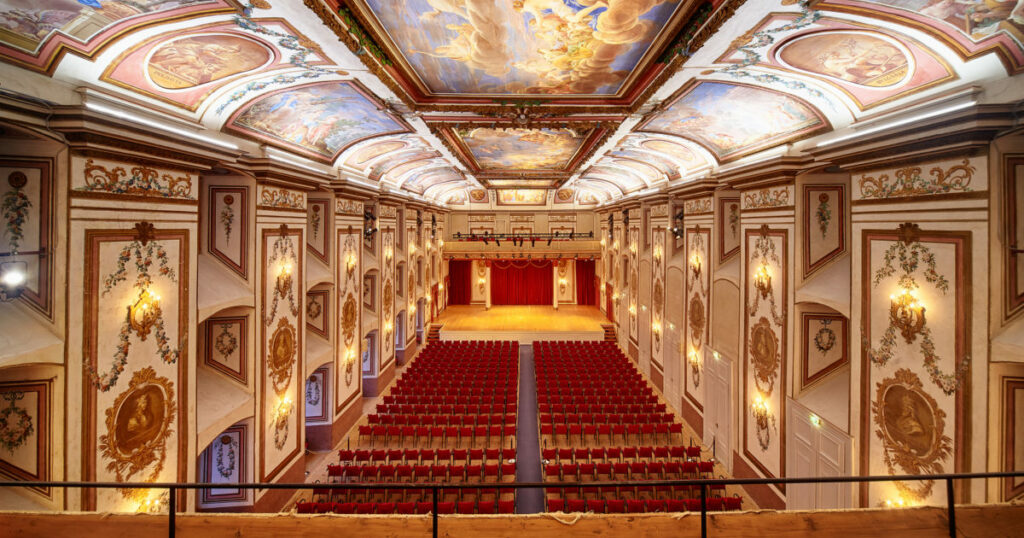
The evolution of music has always been influenced by the acoustics of the spaces in which it is performed. Johann Sebastian Bach, for example, composed organ music specifically tailored to the relatively dry acoustics of the Thomaskirche in Leipzig. On the other hand, Joseph Haydn’s music suited the smaller, more intimate, and acoustically dampened hall of Schloss Esterházy. The growth of orchestras in the late 19th century coincided with advancements in building technology that allowed for larger concert halls, which in turn shaped the music of the late romantic period. The increased reverberation of these larger halls influenced the composers’ approach to orchestration and sound. Today, with electronic music and parametric architecture, the control over sound and space is even more refined, allowing for the precise manipulation of every detail.
Ton Rooijmans’ Graphical Analysis of the Basilica Palladiana
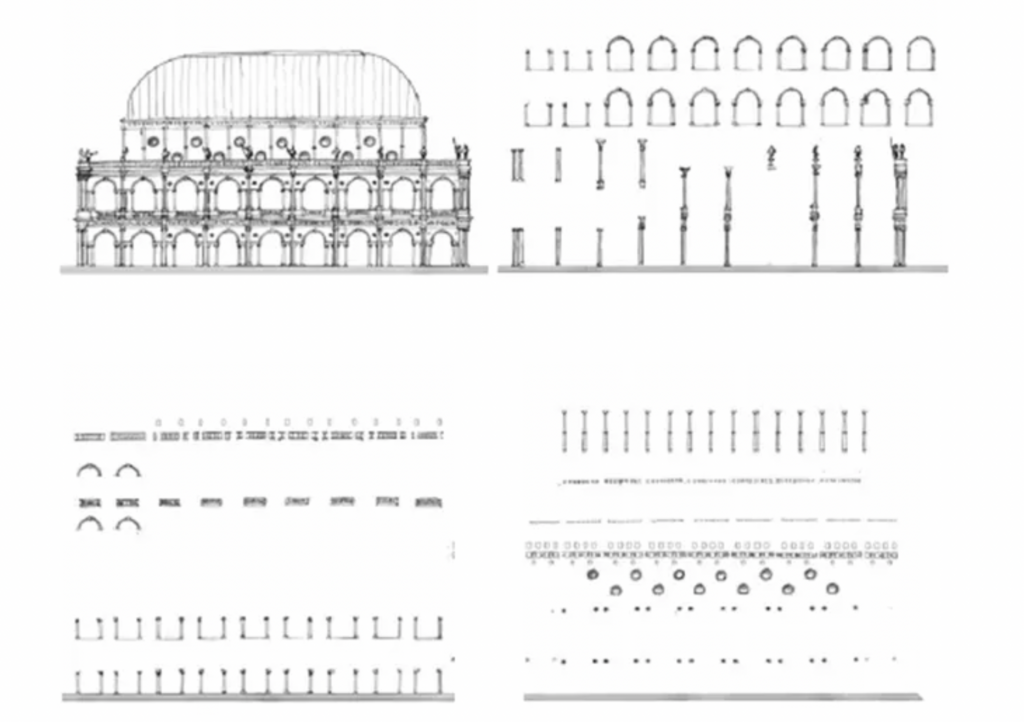
An interesting method of interpreting architecture through sound and rhythm comes from Ton Rooijmans’ analysis of the Basilica Palladiana in Vicenza. Rooijmans uses a graphical approach to translate the formal elements of Andrea Palladio’s building into a visualization resembling a musical score. By doing so, he reveals the building’s rhythmic and harmonic qualities. Horizontal rhythms are visible as they move from left to right, while vertical elements represent chords, highlighting the relationship between different components on various levels. This approach suggests a deep connection between the geometry of architecture and the structure of music.
Iannis Xenakis: Merging Music, Mathematics, and Architecture
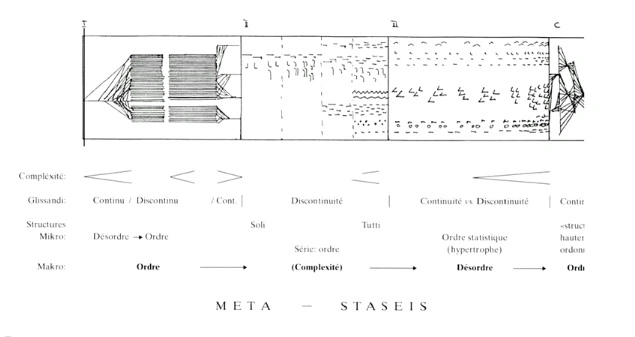
A key figure in the blending of architecture and music is Iannis Xenakis. His composition Metastasis (1953-54) exemplifies his ability to combine mathematics, music, and architecture. In this work, Xenakis used graphical scores to represent the movement and density of sound through diagonal lines that converge and diverge. These lines mirror the architectural drawings Xenakis produced while working with Le Corbusier, specifically for the Philips Pavilion, where he explored complex hyperbolic forms. By using architectural tools to visualize music, Xenakis emphasized the spatial qualities of sound, where time, space, and density converge.
The Façades of La Tourette Monastery: Rhythm and Density
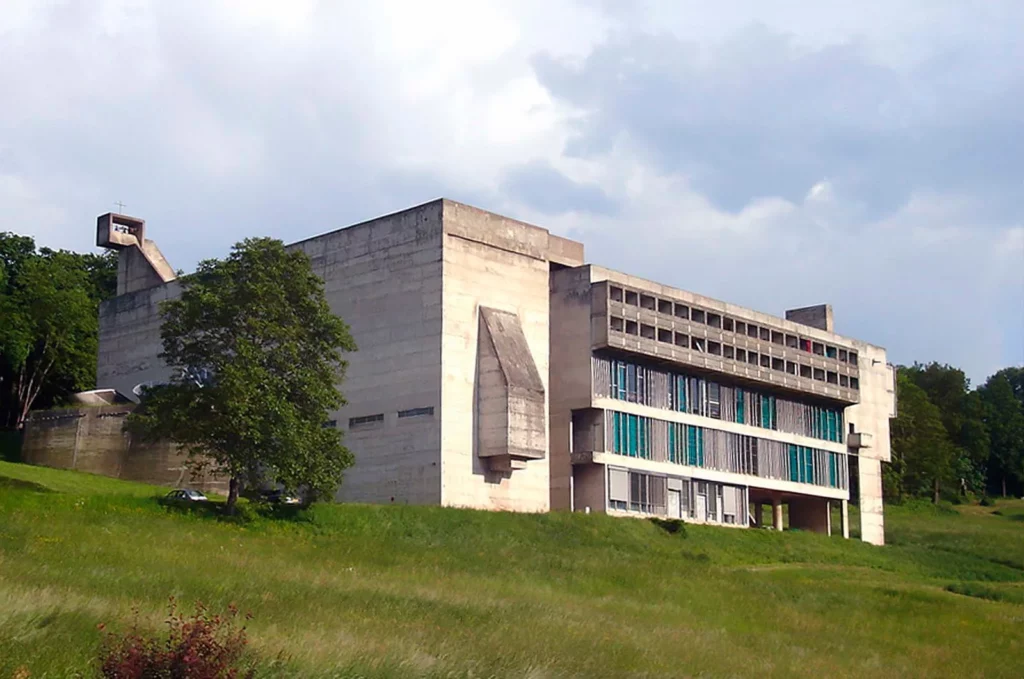
Xenakis’ work on the façades of La Tourette Monastery is another example of his exploration of rhythm in architecture. Initially, Xenakis tried to apply the rhythm from his musical piece Le Sacrifice to the design of the monastery’s windows. However, he found this approach led to a predictable and uninspiring result. Instead, he shifted his focus to density, creating a dynamic rhythm by grouping the windows into areas of greater or lesser density. This change allowed Xenakis the creative freedom to explore more abstract rhythmic patterns, giving the façade a more expressive and varied appearance.
Acoustic Mirrors: A Sound Object

Acoustic mirrors were used in the Second World War to detect enemy planes across great distances. The enormous dishes picked up the sounds of the aeroplanes and conducted them directly to the operator’s ear. The listener could manually aim the dish when he heard something, calling out the angle at which he had received the plane noises to a second person, who could radio the report in to headquarters. The device can be considered a primitive and far from reliable precursor to the radar we use today.
The Mirror-Sound-Laser Experiment
Finally, last past weeks I did the mirror-sound-laser experiment to explore further the relationship between sound, light, and geometry. In this simple setup, a speaker emits sound waves that cause a mirror to vibrate. A laser beam directed at the mirror reflects off its surface. As the sound waves hit the mirror, they cause the laser’s reflection to shift, providing a real-time visual representation of the sound waves. By observing the shifting laser beam, we can make sound visible, further emphasizing the connection between acoustics and geometry.
Conclusion
In conclusion, the relationship between geometry, sound, and space offers a rich and compelling area of exploration. From historical buildings and compositions to modern experiments, the interplay between music and architecture reveals the ways in which both art forms influence and shape one another. As we continue to study these connections, we may uncover even deeper insights into how sound, light, and space can coexist and inspire one another in dynamic, creative ways.
Sources
Space and architecture in amsterdam academy of architecture, study on music, 2012
György dóczi, the power of limits, 1981
Charles jencks , architecture becomes music, may 2023
https://www.architectural-review.com/essays/architecture-becomes-music
Buro happold, music and architecture through the ages, 2021
https://www.ioa.org.uk/system/files/proceedings/16._c_diaz_brito.pdf
https://www.burohappold.com/articles/music-and-architecture-through-the-years/
Eastern engineering group, melodic blueprints: unveiling the impact of architecture on the evolution of music, 2023
https://www.easternengineeringgroup.com/melodic-blueprints-unveiling-the-impact-of-architecture-on-the-evolution-of-music/
Deovrat Dwivedi, architecture and music: overlaps and parallels, august 2021
https://medium.com/@deovratdwivedi14/architecture-and-music-overlaps-and-parallels-c95e9ae98991
Ar. Priyanshi shah, music and architecture: the artful fusion, january 2024
https://thearchitectsdiary.com/music-and-architecture-the-artful-fusion/
Frank Lloyd Wright foundation, the muse of music: wright’s legacy in song, july 2022
https://franklloydwright.org/the-muse-of-music-wrights-legacy-in-song/
Alec Navala Lee – frank lloyd wright on music and architecture, august 2014
https://nevalalee.wordpress.com/2014/08/29/frank-lloyd-wright-on-music-and-architecture/
Ted talks – how architecture helped music evolve, february 2012.
Https://www.ted.com/talks/david_byrne_how_architecture_helped_music_evolve?subtitle=en&lng=it&geo=fr
Ted talks – there is music in every building, march 2019.
Https://www.ted.com/talks/tom_mcglynn_there_is_music_in_every_building?subtitle=en&lng=it&geo=fr
Ted talks – the architecture of sound, 2015.
https://www.youtube.com/watch?v=R-BMF4e-1bg
Alvin lucier – i am sitting in a room, 1969.
Https://www.youtube.com/watch?v=faxhllk3oyk
SketchSynth-Simple
https://jeonghopark.de

